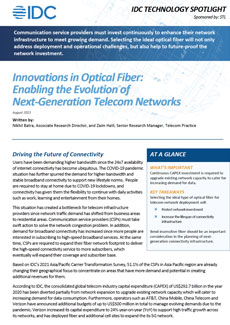Innovations in Optical Fiber: Enabling the Evolution of Next-Generation Telecom Networks
Driving the Future of Connectivity
Users have been demanding higher bandwidth since the 24×7 availability of internet connectivity has become ubiquitous. The COVID-19 pandemic situation has further spurred the demand for higher bandwidth and stable broadband connectivity to support new lifestyle norms. People are required to stay at home due to COVID-19 lockdowns, and connectivity has given them the flexibility to continue with daily activities such as work, learning and entertainment from their homes.
This situation has created a bottleneck for telecom infrastructure providers since network traffic demand has shifted from business areas to residential areas. Communication service providers (CSPs) must take swift action to solve the network congestion problem. In addition, demand for broadband connectivity has increased since more people are interested in subscribing to high-speed broadband services. At the same time, CSPs are required to expand their fiber network footprint to deliver the high-speed connectivity service to more subscribers, which eventually will expand their coverage and subscriber base
Based on IDC’s 2021 Asia/Pacific Carrier Transformation Survey, 51.1% of the CSPs in Asia Pacific region are already changing their geographical focus to concentrate on areas that have more demand and potential in creating additional revenues for them.
According to IDC, the consolidated global telecom industry capital expenditure (CAPEX) of US$292.7 billion in the year 2020 has been diverted partially from network expansion to upgrade existing network capacity which will cater to increasing demand for data consumption. Furthermore, operators such as AT&T, China Mobile, China Telecom and Verizon have announced additional budgets of up to US$500 million in total to manage evolving demands due to the pandemic.Verizon increased its capital expenditure to 24% year-on-year (YoY) to support high traffic growth across its networks, and has deployed fiber and additional cell sites to expand the its 5G network.



